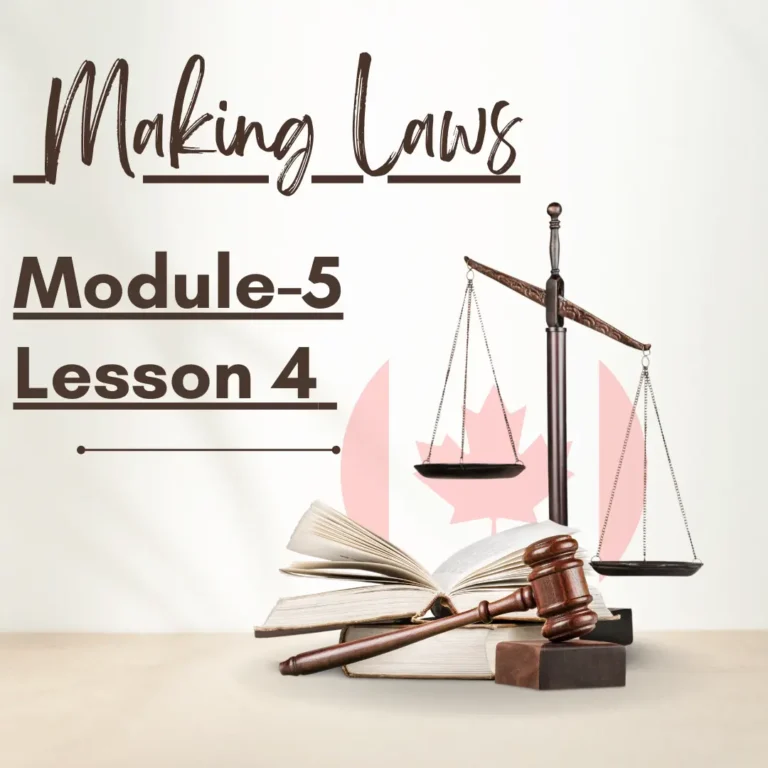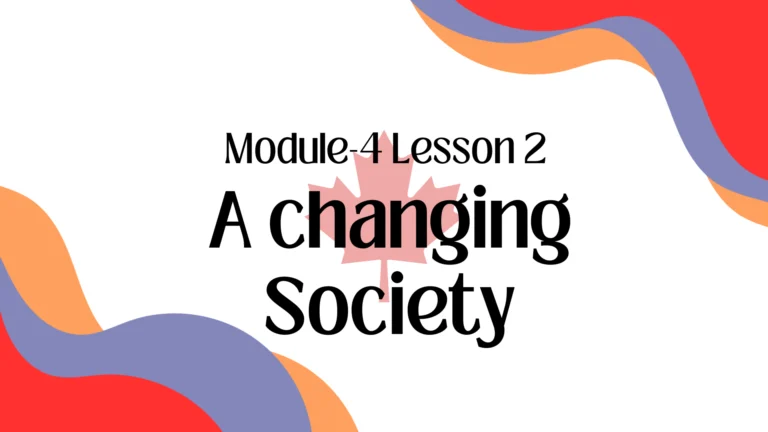Module-7 Lesson 2 Courts
Canadian courts are a vital and complex part of Canada’s legal system. They provide a framework to resolve disputes, administer justice and protect individual rights. The Canadian court system, which is built on a mix of civil and common law, has a hierarchy that spans the federal, provincial and territorial jurisdictions. This essay examines the Canadian Court’s intricacies, its functions and challenges in the pursuit of justice.
The Canadian Court System Hierarchy
1. Supreme Court of Canada:
The Supreme Court of Canada is at the top of the Canadian judiciary system. The Supreme Court of Canada is located in Ottawa and serves as a final appeal court and the supreme interpreter for constitutional issues. The Supreme Court is composed of nine judges, among them the Chief Justice. They are appointed by the Governor General . All lower courts are bounded by the decisions of the Supreme Court, which sets legal precedents for the whole country.
2. Federal Courts:
The federal court system, which is below the Supreme Court of Canada, includes the Federal Court of Canada (also known as the Federal Court of Appeal) and the Tax Court of Canada. The Federal Court of Canada has jurisdiction in matters relating to federal law. This includes immigration, intellectual property, and disputes that involve the federal government. The Federal Court of Appeal or Tax Court of Canada, handles appeals of decisions from the Federal Court.
3. Provincial Courts and Territorial Courts:
The courts of each province or territory are independent from the federal court. There are lower and superior court systems, with the superior courts being the most important trial courts within their jurisdictions. Provincial and territorial courts deal with a variety of cases, including civil and criminal disputes as well as family law cases.
4. Appellate Courts:
Each province or territory also has its own appeal court. The appellate courts review the legal decisions made by the lower courts. This ensures that all issues are thoroughly reviewed. These appellate court decisions provide legal precedent and guidance within the respective jurisdictions.
5. Specialized courts and tribunals
Canada also has a number of specialized tribunals and courts that are focused on certain areas of the law. The Tax Court of Canada is one example, as are the Immigration and Refugee Board and other administrative tribunals. They have specific jurisdictions and add to the expertise and efficiency of the legal system.
The Canadian Court System Functions:
1. Dispute Resolution:
The Canadian courts are primarily responsible for resolving legal disputes. In criminal, civil or family matters, as well as administrative issues, the courts are a place where parties can present their case, provide evidence and try to reach a solution. In the adversarial system, opposing parties can present their arguments before an independent adjudicator (usually a judge or jury).
2. Interpretation and application of laws:
The courts interpret and enforce laws to ensure consistency and fairness. The decisions of judges contribute to the creation of precedents, which guide lower courts. They also establish principles that influence the evolution of law. In interpreting constitutional issues, the Supreme Court of Canada plays an important role.
3. Protection of Rights and Freedoms
Canadian courts are guardians of rights and liberties. Incorporated into the Constitution Act of 1992, the Canadian Charter of Rights and Freedoms provides the framework to protect fundamental rights such as freedom of speech, equality and the right to a fair hearing. The courts play an important role in upholding constitutional guarantees.
4. Criminal Justice:
The court system in criminal cases ensures that those accused receive an impartial trial. The courts determine whether a person is guilty or innocent, give sentences when needed, and help to rehabilitate offenders. Criminal proceedings are guided by the principles of due process and natural justice, which emphasize the rights of the accused.
5. Family Law and Civil Disputes
Family law issues such as divorce, child support, and custody of children are handled by provincial and territorial courts. Civil disputes, including those relating to contracts, personal injuries, and property, are also within the court’s jurisdiction. It is important to reach a just and fair resolution while also considering specific laws that apply to different areas of law.
6. Administrative Law:
Courts and administrative tribunals with specialized jurisdictions deal exclusively with their own issues. The Immigration and Refugee Board, for example, deals with immigration issues, while the Canadian Radio-television and Telecommunications Commission, or CRTC, oversees regulation in the broadcasting and telecommunications sectors. They contribute to the expertise and efficiency of the legal system within their respective areas.
The Canadian Court System: Reforms and Challenges
1. Access to Justice
Access to justice in Canada remains difficult, despite the fundamental principles of equality and fairness. Legal aid is not available to everyone due to high legal fees and geographic restrictions. These barriers are being addressed through reforms to improve access to justice.
2. Case Backlogs and Delays
The backlog of cases and the delays that occur in the legal process are a major problem for courts across Canada. Case management strategies, alternate dispute resolution mechanisms and digitalization initiatives are all aimed at improving the efficiency of justice.
3. Indigenous Rights and Reconciliation
In order to address historical injustices towards Indigenous peoples and recognize their legal tradition, the Canadian court system continues to face challenges. The establishment of Indigenous Courts, incorporation of Indigenous Legal Principles, and collaboration initiatives with Indigenous Communities are all part of reconciliation efforts. The path towards meaningful reconciliation, however, is a complex one that requires ongoing commitment.
4. Legal Technology and Innovation
As technology advances, so does the legal landscape. Legal technology, AI, and online dispute mechanisms offer new opportunities in terms of efficiency and accessibility. Adapting to this change requires consideration of the ethical implications, cyber security concerns and equal access to technology.
- Public Perception of Trust and Reputation:
The legitimacy of the Canadian court system and its effectiveness are dependent on public perception. . Building trust requires a combination of improving transparency, communication with the general public and increasing understanding of the justice system.

Conclusion regarding courts in Canada:
Canadian courts are a crucial institution for upholding and protecting the rule of law, protecting rights as individuals, and resolving disputes. The court system’s hierarchy, which is influenced by civil and common law,. The system is facing challenges in terms of access to justice and case backlogs. It also faces issues with the reconciliation of Indigenous rights.
Canada’s commitment to justice, equality and the rule of law remains unwavering as it continues to develop. Canadian courts play a crucial role in maintaining a delicate balance between the rights of individuals and the needs of society. They contribute to Canada’s goal to create a fair and just society.






